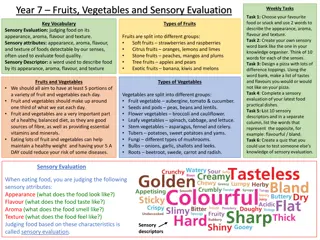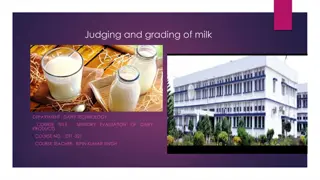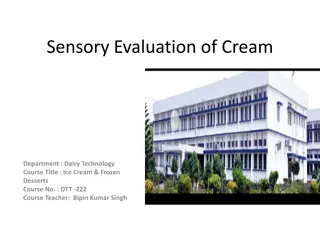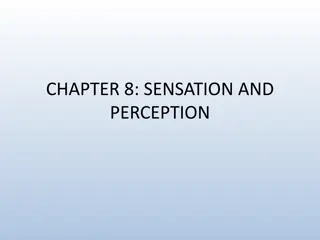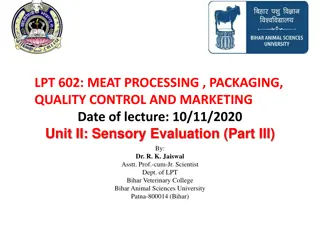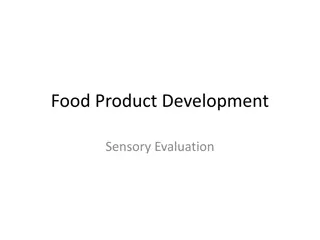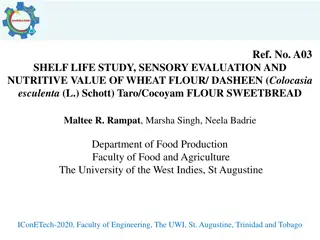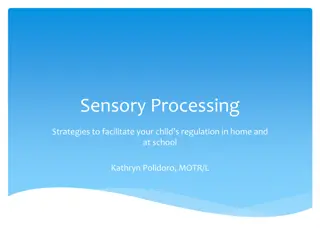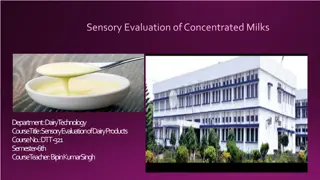Sensory Evaluation: Influences on Food Choices and Evaluation Techniques
Explore the sensory evaluation of food in Chapter 6, focusing on factors influencing food choices such as culture, emotions, and health concerns. Learn about sensory characteristics affecting preferences, taste perception, and the scientific approach to evaluating food through sight, smell, taste, touch, and hearing. Discover the role of sensory evaluation in the food industry, the relationship between sensory characteristics and nutrition, and the impact of flavor, appearance, taste, and odor on food experiences.
Download Presentation

Please find below an Image/Link to download the presentation.
The content on the website is provided AS IS for your information and personal use only. It may not be sold, licensed, or shared on other websites without obtaining consent from the author.If you encounter any issues during the download, it is possible that the publisher has removed the file from their server.
You are allowed to download the files provided on this website for personal or commercial use, subject to the condition that they are used lawfully. All files are the property of their respective owners.
The content on the website is provided AS IS for your information and personal use only. It may not be sold, licensed, or shared on other websites without obtaining consent from the author.
E N D
Presentation Transcript
+ The Sensory Evaluation of Food Chapter 6
+The Sensory Evaluation of Food Objectives Vocabulary Flavor Explain how various influences affect food choices. Garnish Monosodium glutamate Describe sensory characteristics that affect food preferences. Mouthfeel Olfactory Sensory characteristics Plan a setting for successful sensory evaluation. Sensory evaluation Sensory evaluation Sensory evaluation panels Explain the role of sensory evaluation in the food industry. Taste blind Taste buds volatile Explain the relationship between sensory characteristics and nutrition.
+What Influences Food Choices? Culture and Geography Emotions and Psychology Beliefs Health Concerns Food Costs Technology
+Sensory Evaluation: A Scientific Approach Sensory evaluation scientifically testing food, using the human senses of sight, smell, taste, touch and hearing. Sensory characteristics the qualities of a food indentified by the senses. How it looks, tastes, smells, sounds and feels when eaten.
+Flavor and Appearance Flavor distinctive quality that comes from a food s unique blend of appearance, taste, odor, feel, and sound. Appearance-Based on habit and preconceived notions Garnish- a decorative arrangement added to food or drink
+Taste and Odor Taste blind- unable to distinguish between the flavors of some foods. (if you have a cold, you can t taste your food) Taste buds sensory organs located on various parts of the tongue Monosodium glutamate a salt that interacts with other ingredients to enhance salty and sour tastes. Olfactory related to the sense of smell Volatile substances that are easily changed into vapor when heated and add to the odor.
+Comparison Chart Bitter Sour Coffee, bitter melon, unsweetened cocoa, citrus peels. Lemon, orange, grape, melon, wine and sour milk. Sourness taste threshold is rated with respect to dilute hydrochloric acid which has a value of 1. Bitterness of substances is compared with bitter taste threshold of quinine which is 1. Unpleasant and disagreeable taste. Sharp taste that indicates acidity of substance. Bitter flavors are recognized by taste buds at the back of tongue, throat and palate. Taste buds at the sides of tongue recognize sour taste.
+Texture Texture soft, brittle, grainy, chewy, hard, tender, dry, etc Mouthfeel how a food feels in the mouth Sound crunchy foods need to sound crunchy, crackers you don t want to be soggy.
+Sensory Evaluation Sensory evaluation panels groups of people who evaluate food samples Three main groups Highly trained experts Laboratory panels Consumer panels
+Uniform Evaluations Minimize distractions testing takes place in a controlled atmosphere. Light and temperature are kept constant. Minimize bias researchers may mask irrelevant characteristics. Objective Evaluations offer a greater degree of control and consistency.
+Experiment 6 Odor Recognition



